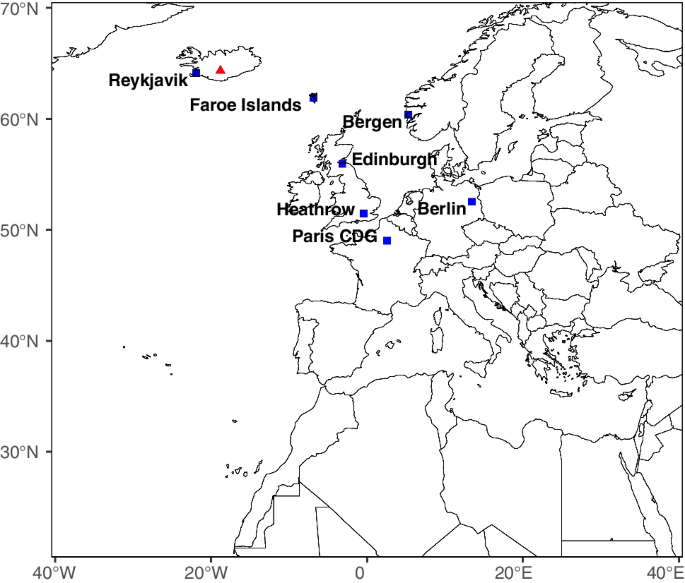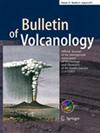量化概率火山灰灾害预报中的不确定性,并应用于基于天气模式的风场采样
IF 3.2
2区 地球科学
Q1 GEOSCIENCES, MULTIDISCIPLINARY
引用次数: 0
摘要
火山灰扩散的概率预测包括模拟一系列现实事件情景,以估计超过特定危险阈值的概率。尽管组成集合的样本数量,它们的选择方式,以及期望的阈值都设置了估计超出概率的不确定性(或置信度),但当前的实践并没有量化和传达集合预测中的不确定性。在本研究中,我们使用标准统计方法来估计概率集合的方差,并使用这种不确定性度量来评估风场的不同采样策略,并以冰岛一次具有代表性的爆炸喷发的火山灰运输为例。对于风场的随机抽样,我们展示了方差如何随着集合规模的增加而减小,以及方差如何取决于期望的危险阈值和目标地点与火山源的接近程度。我们通过比较随机预报和分层抽样方法获得的预报,展示了如何使用估计方差来比较不同的集合设计,这些方法使用一组29个北欧天气制度,称为格罗斯维特拉根(GWL)。与传统的随机抽样相比,从GWL范围内采样风场减少了实现相同方差所需的样本数量。我们的研究结果表明,火山灰分散预测的不确定性可以直接计算和沟通,并突出了火山灰预测界和业务最终用户共同选择可接受的方差水平的必要性。本文章由计算机程序翻译,如有差异,请以英文原文为准。

Quantifying uncertainty in probabilistic volcanic ash hazard forecasts, with an application to weather pattern based wind field sampling
Abstract Probabilistic forecasting of volcanic ash dispersion involves simulating an ensemble of realistic event scenarios to estimate the probability of a particular hazard threshold being exceeded. Although the number of samples that make up the ensemble, how they are chosen, and the desired threshold all set the uncertainty of (or confidence in) the estimated exceedance probability, current practice does not quantify and communicate the uncertainty in ensemble predictions. In this study, we use standard statistical methods to estimate the variance in probabilistic ensembles and use this measure of uncertainty to assess different sampling strategies for the wind field, using the example of volcanic ash transport from a representative explosive eruption in Iceland. For stochastic (random) sampling of the wind field, we show how the variance is reduced with increasing ensemble size and how the variance depends on the desired hazard threshold and the proximity of a target site to the volcanic source. We demonstrate how estimated variances can be used to compare different ensemble designs, by comparing stochastic forecasts with forecasts obtained from a stratified sampling approach using a set of 29 Northern European weather regimes, known as Grosswetterlagen (GWL). Sampling wind fields from within the GWL regimes reduces the number of samples needed to achieve the same variance as compared to conventional stochastic sampling. Our results show that uncertainty in volcanic ash dispersion forecasts can be straightforwardly calculated and communicated, and highlight the need for the volcanic ash forecasting community and operational end-users to jointly choose acceptable levels of variance for ash forecasts in the future.
求助全文
通过发布文献求助,成功后即可免费获取论文全文。
去求助
来源期刊

Bulletin of Volcanology
地学-地球科学综合
CiteScore
6.40
自引率
20.00%
发文量
89
审稿时长
4-8 weeks
期刊介绍:
Bulletin of Volcanology was founded in 1922, as Bulletin Volcanologique, and is the official journal of the International Association of Volcanology and Chemistry of the Earth’s Interior (IAVCEI). The Bulletin of Volcanology publishes papers on volcanoes, their products, their eruptive behavior, and their hazards. Papers aimed at understanding the deeper structure of volcanoes, and the evolution of magmatic systems using geochemical, petrological, and geophysical techniques are also published. Material is published in four sections: Review Articles; Research Articles; Short Scientific Communications; and a Forum that provides for discussion of controversial issues and for comment and reply on previously published Articles and Communications.
 求助内容:
求助内容: 应助结果提醒方式:
应助结果提醒方式:


